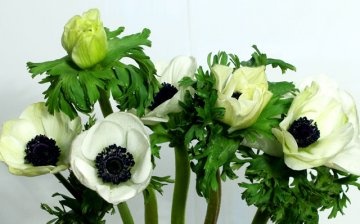Anemones. What types to choose for a flower garden?
In the family of ranunculaceae (Ranunculaceae) you can find the anemone (Anemone), its second name is the genus anemone. It consists of a huge number of flowers, which have about 150 species. They grow in flat areas, in the mountains. They bloom at different times of the year. Some in spring, others in summer or fall. This name comes from the word "anemos", which means wind and is of Greek origin. The wind was the primary reason for this name due to the fact that it is believed to be the main pollinator of flowers, thanks to it, seeds are spread. There is another interpretation of the name. According to the second version, the name comes from the fact that the heads of these flowers swing very beautifully to the beat of a light breeze. In the name of the anemones there is a root "wind", it can be found in many European languages.
Content:
Spring anemones
Such spring anemones are distinguished by their graceful appearance and have carved leaves. Their beauty strikes the eye throughout the entire period of their growth. From the very appearance of flowers to their rapid growth, they never cease to amaze everyone with their beauty. The variety of their colors is also multifaceted: cream, pink, lilac, blue, white, yellow, etc. Sometimes you can find flowers with a double shade. You can also find the oak anemone (Anemone nemorosa), anemone buttercup (Anemone ranunculoides), their joint hybrid Anemone x lipsiensis and tender anemone (Anemone blanda). The flowers of these plants are in the shape of a cup, as a rule, they begin to bloom in the spring. At the present time, such plants are gaining more and more popularity. Plants that grow very quickly are called ephemeroid anemone.
These plants sprout already in April, and in May, single flowers with thin peduncles appear on them. They rise above the stems to a distance of about 6 cm. Small beautiful flowers have a diameter of up to 5 cm, the height of their clumps is from 10 to 25 cm. At the beginning of summer, such plants already fade and wither. Occasionally you can find these flowers that have grown and survived until the beginning of autumn. The described plants grow in different directions, this is due to the root. In flowers such as buttercup anemone and oak anemone, the oak rhizome has a fragile structure, in each of its sections you can see a bud, which will give a new shoot the next year. In contrast to these anemones, the rhizome of the anemones of the Uda rhizome has a more rigid structure, but it is rather thin. The roots grow horizontally not too deeply, at about a depth of about 5 cm. But the root of the tender anemone looks like a tuber, it is dense in texture, it grows very slowly.
It will look great in the foregrounds of the tender anemone flower garden.
It is recommended to plant such an anemone in small groups, as it grows rather slowly. You can combine it with other plants, together they will create a magnificent landscape. For this, conifers, miniature shrubs and other perennial plants. But you should choose exactly those perennials that do not require frequent transplantation, as it can harm the root system of the anemone. With the help of buttercup anemones, lipsiensi and oak groves, you can create a beautiful composition that will resemble a forest edge, a flower garden in the shade, a flower carpet under the crowns of trees and shrubs, a fern garden, etc. All the described varieties of anemone grow well with each other. Green anemones are ideal for planting in the foreground in these flower beds.As for the Uud anemone, it can be planted in a shaded garden.
Anemones growing in autumn
The autumn anemone group includes the Japanese anemone (A. japonica), the Hubei anemone (Anemone hupehensis), the felt anemone (A. tomentosa), the vine-leaved anemone (A. vitifolia) and their garden-type hybrids. They are perennial plants with a powerful rhizome. Such anemones bloom from August to October. Their peduncles have a slender stem, the height of which is up to 1.5 meters. On such anemones, you can see beautiful flowers of various shades: pink, purple, white, terry, etc.
These types of plants, as a rule, are rarely grown, since they are slightly inferior in decorative characteristics to garden hybrids. This is a hybrid anemone (A. x hybrida), a Japanese anemone, a grape-leaved anemone.
Autumn types of anemone will decorate any garden. Their combination with asters, ornamental grasses, steep, aconites, rudbeckia. Advice - you should not plant such plants near anemones that grow too quickly and require frequent replanting. Anemones have beautiful leaves that last throughout the flowering season, so you shouldn't think about planting other perennials nearby. You can plant anemone blooming in the fall, singly or in a small group of plants. They create harmonious and beautiful shrubs. If the anemone grows near the bushes, then the result is a magnificent edge that will bloom for a long time. Small-bulbous or Pushkinia or Chionodoxa spines will look beautiful if planted in a clump of anemone.






Beautiful flowers, only they have one small drawback - they are very fond of watering, their root is often eaten up by rodents and they stand little in the cut. Although the club and the garden look just great.
In some way, these flowers resemble bathers, most likely with cut leaves. Therefore, they probably also love water.